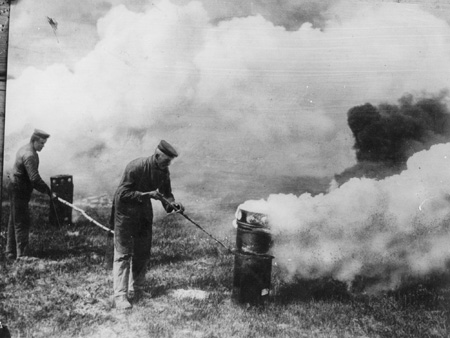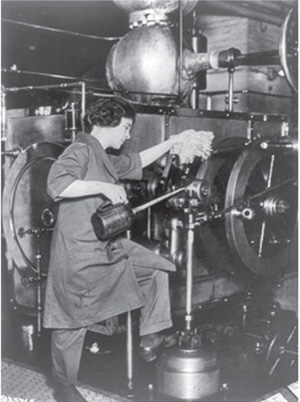




Back to the Around WWI calendar



I said in the 1914 section that this was a war unlike anything seen before and events in this year showed that even more. Previously, if a war was fought in a country, then the ordinary people living in other countries didn't get involved. The fighting was mainly done by soldiers. Now new inventions began to play a part in the fighting.
The aeroplane and the airship became weapons of war. Initially used for spying, you can see more from 200 feet in the air, they soon were used for dropping bombs and each side's air force would indulge in battles in the air trying to shoot each other down.
 In 1915 two German airships, known as Zeppelins, attacked Great Yarmouth and King's Lynn in Norfolk. The bombs they dropped killed 4 people and it was the start of occasional raids over the next 3 years. In total 1,413 people were killed by Zeppelin attacks and aeroplane bombing raids during the war. The German King initially banned bombing London in case the Royal family, to whom he was related, were killed. The ban didn't last too long.
In 1915 two German airships, known as Zeppelins, attacked Great Yarmouth and King's Lynn in Norfolk. The bombs they dropped killed 4 people and it was the start of occasional raids over the next 3 years. In total 1,413 people were killed by Zeppelin attacks and aeroplane bombing raids during the war. The German King initially banned bombing London in case the Royal family, to whom he was related, were killed. The ban didn't last too long.
The worst raid in terms of casualties took place on 13 June 1917 when 20 Gotha GI.V bombers attacked London; 162 people were killed and 432 injured. Particularly traumatic was the death of schoolchildren: a bomb struck Upper North Street School in Poplar, killing 18 young children. On 7 July, a further daylight raid resulted in 57 civilian deaths, prompting public anger and newspaper reports about the lack of warning and absence of effective defences. Targeted on the civilian population rather than military sites, these aerial attacks emphasised the random quality of warfare. Out of the blue, anyone living in a town or port within range of bombers and airships could lose their life. War had come to ordinary people.
 Meanwhile the fighting on land continued. More trenches were dug, more soldiers recruited, more soldiers killed and even more wounded. Between 22 April 1915 and 25 May 1915 there was a a major battle for the Flemish town of Ypres. During the fighting the Germans released cannisters of a gas called chlorine causing over 7,000 British, Canadian and French casualties. Canadians were now fighting as Britain had asked for soldiers from its Empire and Australians, New Zealanders, South Africans and Indians also joined in.
Meanwhile the fighting on land continued. More trenches were dug, more soldiers recruited, more soldiers killed and even more wounded. Between 22 April 1915 and 25 May 1915 there was a a major battle for the Flemish town of Ypres. During the fighting the Germans released cannisters of a gas called chlorine causing over 7,000 British, Canadian and French casualties. Canadians were now fighting as Britain had asked for soldiers from its Empire and Australians, New Zealanders, South Africans and Indians also joined in.
Under the rules of war (yes war has rules but rules breed cheats) called the Hague Convention agreed in 1907 the use of poison or poisoned weapons was not allowed. The Entente nations protested to Germany who replied that the Hague Treaty had only banned weapons not gases.
 War had changed at sea too. Instead of the grand sailing ships of Nelson's time, the modern battleship was made of steel with incredibly powerful guns which could fire a very long distance. Also the submarine or U-boat had been invented. The British called the German submarines U-boats as it was an abbreviation of the German word Unterseeboot which even if you can't speak German you can probably tell means undersea boat. These boats would glide silently underwater and then come to the surface to fire torpedoes which would explode when they hit the hull of another ship.
War had changed at sea too. Instead of the grand sailing ships of Nelson's time, the modern battleship was made of steel with incredibly powerful guns which could fire a very long distance. Also the submarine or U-boat had been invented. The British called the German submarines U-boats as it was an abbreviation of the German word Unterseeboot which even if you can't speak German you can probably tell means undersea boat. These boats would glide silently underwater and then come to the surface to fire torpedoes which would explode when they hit the hull of another ship.
At first there was a convention (a convention is a bit less than a rule but still open to cheating) that only military ships would be attacked. However some merchant ships would carry weapons and ammunition across the Atlantic Ocean from the United States of America to Britain so were these military ships too? On 7 May 1915, a German U-boat torpedoed and sank a passenger liner, the Lusitania. The sinking claimed 1,198 lives. It is now thought that the Lusitania was actually carrying some military cargo as well as all those passengers but the attack was yet another example of ordinary people dying in this conflict.
 Meanwhile, even if there was no fighting in Britain, the effects of the war were still being felt. As more and more young men went off to fight so women were recruited into their jobs. Women would work in factories doing the jobs the men had done but possibly, and I haven't checked this, not getting the same pay the men received.
Meanwhile, even if there was no fighting in Britain, the effects of the war were still being felt. As more and more young men went off to fight so women were recruited into their jobs. Women would work in factories doing the jobs the men had done but possibly, and I haven't checked this, not getting the same pay the men received.
Women, particularly nurses, went across to France to help with the many wounded soldiers that were there. The injuries the men had received were terrible, including from the gas attacks but also with loss of limbs from the guns.
 One of the most famous of these nurses was a lady called Edith Cavell. She had been born in England in 1865 so was nearly 50 when the war began. Before then she had worked in Belgium as a governess but after returning to England to look after her sick father she decided to train as a nurse. She then returned to Belgium and became matron of a Nursing School there.
One of the most famous of these nurses was a lady called Edith Cavell. She had been born in England in 1865 so was nearly 50 when the war began. Before then she had worked in Belgium as a governess but after returning to England to look after her sick father she decided to train as a nurse. She then returned to Belgium and became matron of a Nursing School there.
Once war broke out, and much of the fighting was in Belgium, she and her staff looked after all wounded soldiers regardless of which side they were fighting on and she was criticised for this. However she also began to work with others to smuggle Allied soldiers out of her hospital and across the border into the Netherlands who were neutral. It is believed that she saved the lives of over 200 men thanks to her bravery.
However the Germans became aware of this and Edith was arrested, sent to trial and found guilty of treason. At dawn on 12 October 1915, despite international pressure for mercy, Edith Cavell was put to death by a German firing squad.
Her execution received worldwide condemnation and extensive press coverage. Her image and story were widely used in propaganda and recruitment posters encouraging British soldiers to sign up to the war effort. You can find out more, as I did, from this website
 Meanwhile, early in the year, bogged down in trenches in France and Belgium, Britain decided to attack the Turks who were allies of the Germans. They wanted to be able to control the Dardanelles, a narrow stretch of water linking the Mediterranean Sea to the Turkish capital of Istanbul. They thought that if the Turkish
capital was captured, the Turks might surrender.
Meanwhile, early in the year, bogged down in trenches in France and Belgium, Britain decided to attack the Turks who were allies of the Germans. They wanted to be able to control the Dardanelles, a narrow stretch of water linking the Mediterranean Sea to the Turkish capital of Istanbul. They thought that if the Turkish
capital was captured, the Turks might surrender.
On April 25 1915, they landed troops on the beaches of Gallipoli but then were unable to move further inland because of the cliffs and suffered a
gigantic defeat. The casualties were enormous, many of them being soldiers from Australia and New Zealand who had come thousands of miles from their home to fight
in a war that didn't remotely affect their country. Over 11,500 Australian and New Zealand troops died and nearly 25,000 were wounded. Nearly 400,000 people were killed or injured in the Gallipoli campaign on both sides.
April 25 is now commemorated as ANZAC day and is a public holiday in both Australia and New Zealand.
ANZAC stood for the Australian and New Zealand Army Corps.
One of the instigators of this campaign was Winston Churchill, at the time the politician who was head of the navy. Several things contributed to the defeat but Churchill was the man who, quite rightly, took much of the blame. He was demoted to a lower government post but returned a few years later.
When I was young in the nineteen sixties we had a lot of so-called protest singers who sang songs against war. The song in this video, written by a Scotsman who went to live in Australia, tells the suffering that war brings to the soldiers who are wounded. It is all about the Gallipoli campaign and the singer, Eric Bogle, imagines a story of one soldier and sings of that soldier's feelings. The reference to Waltzing Matilda is that at that time it was the Australian National song.
Forward to 1916AD

